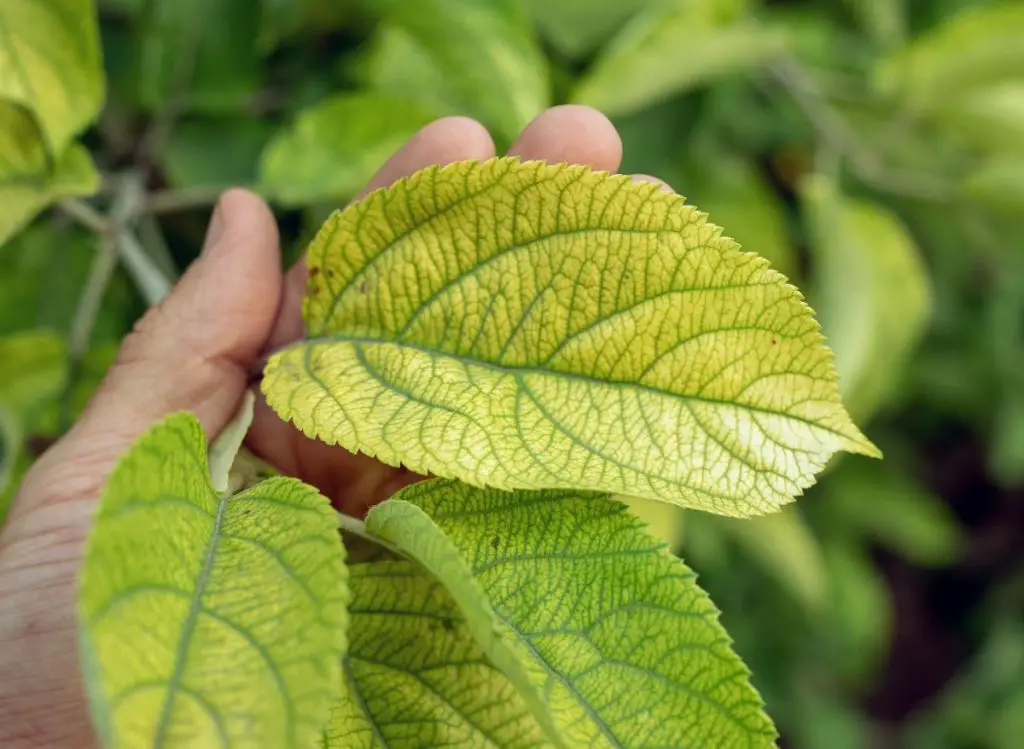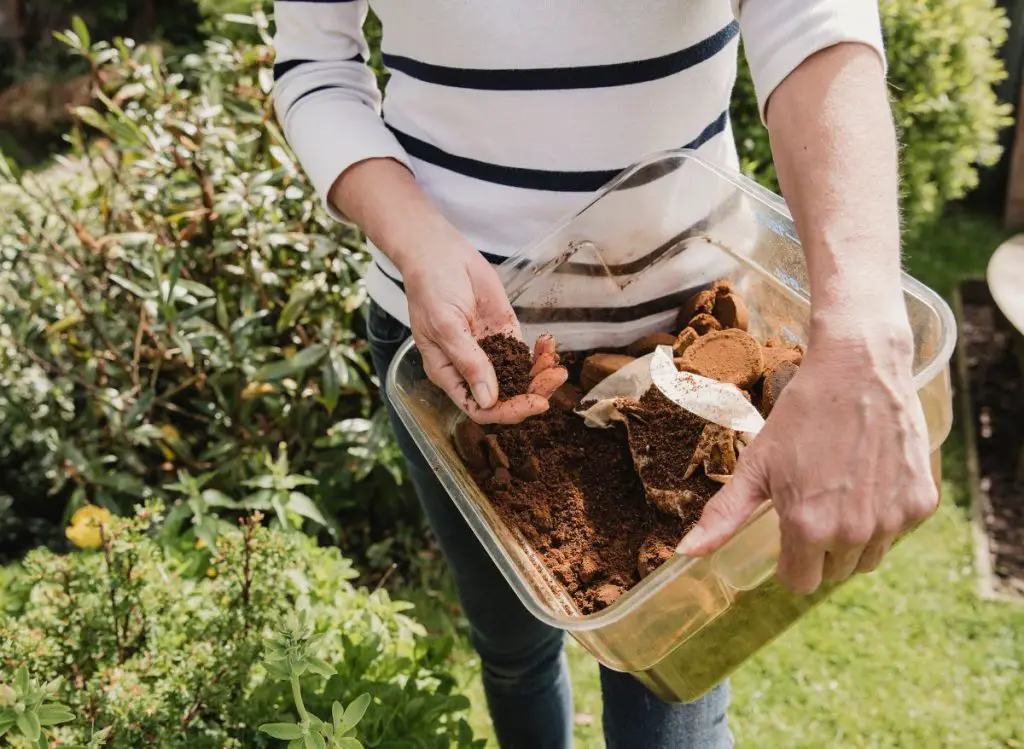This post contains affiliate links.

Iron is an essential micronutrient that plants need to grow healthy and strong, as it is responsible for many critical functions, including photosynthesis and nitrogen fixation. Without enough iron, plants suffer from stunted growth and yellowing leaves, known as chlorosis. Therefore, it is essential to ensure that your plants have access to sufficient iron.
Are you wondering what the best source of iron for your plants is? One of the most common and cheapest sources of iron for your plants is ferrous sulfate; spray it on plant leaves by mixing 1 to 2 oz of ferrous sulfate in 1 gallon of water. Other sources of iron for your plants include blood meal, compost, coffee grounds, seaweed extract, fish emulsion, and chelated iron.
Read on to explore the best sources of iron for plants and help keep plants happy and healthy. Also, check out this article if you are wondering how too much Iron in your lawn can really affect your lawn’s health.
1- Chelated Iron
Chelated iron, also known as iron EDTA, is an excellent source of iron that’s frequently added to nutrient mixes to supply plants with the desired amount of iron.
Generally, Chelated iron can come as iron chloride, iron sulfate, iron nitrate, or ferrous sulfate, bound to a chelating agent that enables the iron to remain in a stable, water-soluble form. Chelated iron is also perfect for hydroponics, as it is easily absorbed into the system.
There are four commonly used chelates (Source: Michigan State University)
- Citric acid: citric acid does not strongly bond with iron and is ineffective at pH levels above 6.0.
- EDTA: EDTA strongly maintains iron in solution up to pH 6.0, but by pH 6.5, nearly one-half the iron is poured, and by pH 7.0, virtually none of the iron is available to plants
- DTPA is a fantastic iron source up to a media pH level of 7.0, but 60 percent of the iron is poured and unavailable by pH 8.0
- And EDDHA is the strongest chelate of any commonly used materials and keeps iron available to plants past pH 9.0.
Read this interesting article from the University of Florida to understand and learn how to apply Chelated fertilizers based on your soil’s pH.

2- Iron Sulphate
Iron sulfate (often sold under the name ferrous sulfate) is an affordable and readily available source of iron, and it is commonly used as a lawn tonic to give grass a deep green color.
Moreover, Iron sulfate can also be used to treat iron deficiency in plants. However, it is essential to apply it in the right amount, as too much iron can be harmful to plants. It is also essential to note that iron sulfate might also stain pathways, driveways, and patios; that is why it might be best to apply it when you have ample time to water the area after application.
Also, Iron sulfate is highly soluble with quick results and can easily be applied to the soil or foliage. Generally, Iron sulfate is most suitable for plants like azaleas, camellias, and gardenias that thrive well in acidic soils. It can be applied in solid form or as a liquid fertilizer to boost a plant’s iron levels.

3- Coffee Grounds
Coffee is a rich source of iron, and it is easily accessible to many of us. Instead of throwing your used coffee grounds away, use them to feed your plants.
You can add the grounds to your compost pile or sprinkle them around the base of plants as nutrient-rich mulch. The benefit of using coffee grounds is that they also increase the acidity of the soil, making it ideal for acid-loving plants such as roses, blueberries, and azaleas.
Read the articles below:
- If you wonder how to use coffee grounds as a fertilizer effectively.
- A list of plants that like coffee grounds: With helpful tips on how to grow them properly.

4- Fish Emulsion
Fish emulsion is a liquid fertilizer made from fermented fish waste and water. In addition, fish emulsion is a rich source of nitrogen, phosphorus, and potassium, and it also contains several micronutrients such as iron and zinc, making it an excellent choice for feeding hungry plants.
The added benefit of fish emulsion is that it also helps to improve soil structure, making it easier for water and air to reach plant roots.

5- Molasses
Molasses is a thick, brown syrup made from sugar cane. It is a natural source of iron, magnesium, and potassium, making it an excellent choice for plant nutrition.
Molasses is also an effective soil conditioner, helping to improve soil biology and making it easier for plants to access nutrients trapped in the soil. Moreover, it also acts as a natural microbial booster, making it an excellent choice for plant growth.
Blackstrap molasses is high in iron, calcium, magnesium, and potassium and contains sulfur and micronutrients. Using molasses as a fertilizer provides plants with a quick energy source and promotes the growth of beneficial microorganisms.
6- Blood Meal
A blood meal is a natural, slow-release source of nitrogen and iron made from slaughterhouse waste. Blood meal contains high amounts of iron, and nitrogen, making it an excellent option for plants that need a quick iron fix.
However, it’s essential to note that blood meal can attract animals, resulting in soil disturbance. On the other hand, you can also use blood meal as a deterrent for some animals, including moles, squirrels, and deer, because the smell of blood meal does not appeal to these animals (Source: Gardening Know How)
7- Compost
Many gardeners choose to add compost to their soil to supply their plants with the nutrients they require. This nutrient-rich soil amendment also happens to be a good source of iron, typically containing approximately 1% iron.
Adding compost to soil also improves soil structure and water retention abilities, which can boost plant growth.

8- Seaweed Extract
Seaweed extract is a natural, organic source of iron that’s typically purchased in concentrated liquid form. It’s derived from sea kelp and is rich in micronutrients, including iron, nitrogen, and potassium.
Seaweed extract can improve root growth, boost plant vigor, and increase the plant’s resistance to stress. Plus, seaweed extract is ideal for use as a foliar spray to supply plants with a quick iron boost.
What to read next:
- Effective Ways To Combat Too Much Iron In Your Garden’s Soil.
- Best Ways to Control Earthworms in Your Garden Soil.
- Grow Your Garden on a Budget: Best, Cheaper, And Organic Alternatives to Miracle-Gro!
Wrapping Up
Iron is an essential micronutrient for plants, and when they do not have access to sufficient quantities, they will suffer from iron deficiency. Luckily, there are several sources of iron that can help combat iron deficiency, and each one offers unique benefits.
Remember that different plants require varying amounts of iron. For example, some will require more iron than others, and it is also essential to consider the soil pH levels and other environmental factors when choosing an iron source.
And more importantly, be sure to choose the right type of iron source for your plants and use them in the right amount. I believe that with a little bit of attention and care, you can keep your plants happy and healthy all year round.

